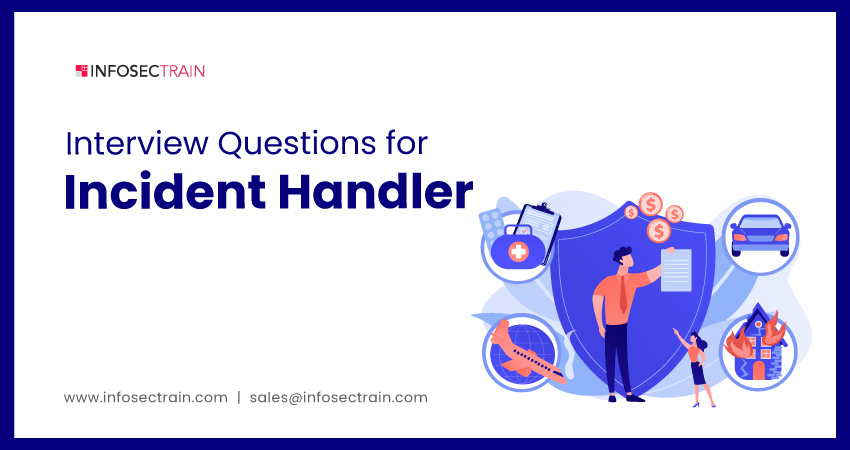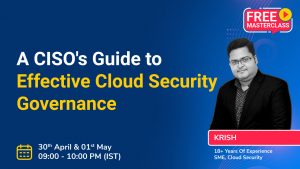Interview Questions for Incident Handler
Organizational cybersecurity is essential in the modern digital environment, where cybercrime and data breaches continue to present serious business problems. With growing awareness and strict policies, companies are investing a lot to protect their infrastructure and data from numerous attacks. Whenever issues arise, an organization works quickly to handle problems and takes the appropriate precautions to avoid them in the future. Therefore, Cybersecurity Incident Handlers are present in all sizes of enterprises.

The Incident Handler keeps track of and resolves any security incidents that may occur within a business. They gather and analyze information about a cyber threat or attack and identify the root cause. They also implement quick service and system recovery and instruct other security analysts, cybersecurity experts, and team members on how to halt the attack.
Today, Incident Handler job opportunities are growing all across the world, which makes interviews more challenging. You can speed up your preparation and land the job by using the most relevant Incident Handler interview questions and answers given below.
Interview Questions
1.What is incident handling?
Incident handling is the process and predetermined procedural action used to manage and handle an incident effectively and practically. It involves the planning and implementation stage before, during, and after an incident is identified.
2. What is the incident response?
Incident response refers to an organization’s procedures and tools for analyzing, identifying, defending against, and responding to a cyber incident, security breaches, or cyberattacks. The purpose of incident response is to mitigate cyberattacks before they occur and reduce the cost, recovery time, and reputational harm that cyberattacks may cause businesses.
3. What is NIDS?
A Network-based Intrusion Detection System (NIDS) is an intrusion detection system that monitors and examines network traffic to defend a system from network-based threats. Also, it detects malicious activity by identifying anomalies in incoming packets.
4. What is HIDS?
Host-based Intrusion Detection System (HIDS) is an intrusion detection system that monitors and analyzes the computer infrastructure for any suspicious activities as well as the network packets on its network interfaces. It can involve internal misuse of resources or data and external invasions.
5. What are the six phases of a cyber incident response plan?
Six phases of cyber incident response plan:
- Preparation
- Identification
- Containment
- Eradication
- Recovery
- Lessons learned
6. What are some prevalent kinds of insider threats?
Some typical inside threats include:
- Malicious insiders
- Departing personnel
- Negligent employees
- Security evaders
- Inside agents
- Third-party partners
7. What are the best methods for preventing insider threats?
To prevent insider threats, take some of the procedures listed below.
- Implement security policies
- Implement security software and tools
- Use a unique and complex password
- Implement account management policies and practices
- Use Multifactor Authentication
- Implement secure backup and recovery procedures
- Establish physical security in the workplace
- Educate employees
8. What are the key elements of incident response?
There are three main elements of incident response:
- Incident response plan
- Incident response team
- Incident response tools
9. What are the most commonly used incident response technologies?
The most commonly used incident response technologies include:
- SIEM (Security Information and Event Management)
- EDR (Endpoint Detection and Response)
- UEBA (User and Entity Behavior Analytics)
- SOAR (Security Orchestration, Automation, and Response)
- XDR (Extended Detection and Response)
- ASM (Attack Surface Management)
10. What are the benefits of an Incident Response Plan (IRP)?
Benefits of IRP:
- Ability to deal confidently with incidents
- Faster mitigation
- Enhances overall security
- Maintains client faith
- Maintains compliance
11. What are the best practices for incident response?
Best incident response practices:
- Develop an Incident Response Plan (IRP)
- Establish a security incidents playbook
- Establish a communication plan and procedure
- If you lack the required resources, outsource to an MSP
- Keep your incident response method clear and simple
12. How can incoming threats be identified?
First, use SIEM to identify unusual and suspicious activity. Afterward, determine the origin of the activity and then plan your strategy accordingly. These steps can help in the early detection of potential threats and open the door to full security.
13. What are different penetration testing methods?
Here are five different penetration testing methods :
- Internal testing
- External testing
- Targeted testing
- Blind testing
- Double-blind testing
14. What are the two primary frameworks for handling cybersecurity incidents?
The two primary frameworks for handling cybersecurity incidents are:
- National Institute of Standards and Technology (NIST)
- SysAdmin, Audit, Network, and Security Institute (SANS)
15. What differentiates the NIST and SANS frameworks?
NIST: The NIST framework is one of the most widely used methodologies for comprehending and managing cybersecurity risk. It includes details on how to set up an incident response team, an Incident Response Plan (IRP), a communication plan, and training scenarios. This framework covers the four phases that condense the six phases of incident response:
- Preparation
- Detection and Analysis
- Containment, Eradication, and Recovery
- Post-Incident Activity
SANS: Comparatively to the NIST framework, which has a more comprehensive operational scope, the SANS framework solely focuses on security. This framework includes six phases:
- Preparation
- Identification
- Containment
- Eradication
- Recovery
- Lessons Learned
16. What does OODA stand for?
OODA stands for Observe, Orient, Decide, and Act, is a four-step decision-making process. It is a set of techniques for detecting, investigating, and handling potential security problems in a way that limits incidents and enables speedy recovery in a real-time environment.
17. What is LogRhythm?
LogRhythm is a NextGen SIEM platform that unifies comprehensive security analytics, automated responses, network and endpoint monitoring, real-time monitoring, and log management.
18. What are the email security incidents?
Some of the top email security incidents are:
- Spam: Spam is unsolicited, unwanted emails that are distributed in bulk.
- Phishing: Phishing involves cybercriminals pretending to be someone else to gain the victim’s trust and then manipulating them into taking action.
- Business Email Compromise (BEC): BEC is a phishing email attack intended to steal a company’s finances.
- Malware delivery: Phishing emails can either download malware into the victim’s system directly through the attachments or link them to websites that download malware.
- System takeover: A successful phishing attack allows the hacker to install malware and enables them to take over the system.
19. What is an Incident Response Team?
An Incident Response Team is a team who is in charge of organizing and responding to IT incidents, such as cyberattacks, system outages, and data breaches. They are also in charge of creating incident response plans, identifying and fixing system flaws, enforcing security regulations, and assessing best security practices.
20. List the different types of Incident Response Teams.
Incident Response Teams come in three main categories.
- Computer Security Incident Response Team (CSIRT)
- Computer Emergency Response Team (CERT)
- Security Operations Center (SOC)
Certified Incident Handler with InfosecTrain
We hope the interview questions and answers will help you ace the Incident Handler job interview. InfosecTrain is here to help if you require additional information on incident handling and response. You can join our EC-Council Certified Incident Handler training course to enhance your knowledge and skills. With the aid of our experienced and certified instructors, you will receive the best training to become a successful Incident Handler.




 1800-843-7890 (India)
1800-843-7890 (India) 
